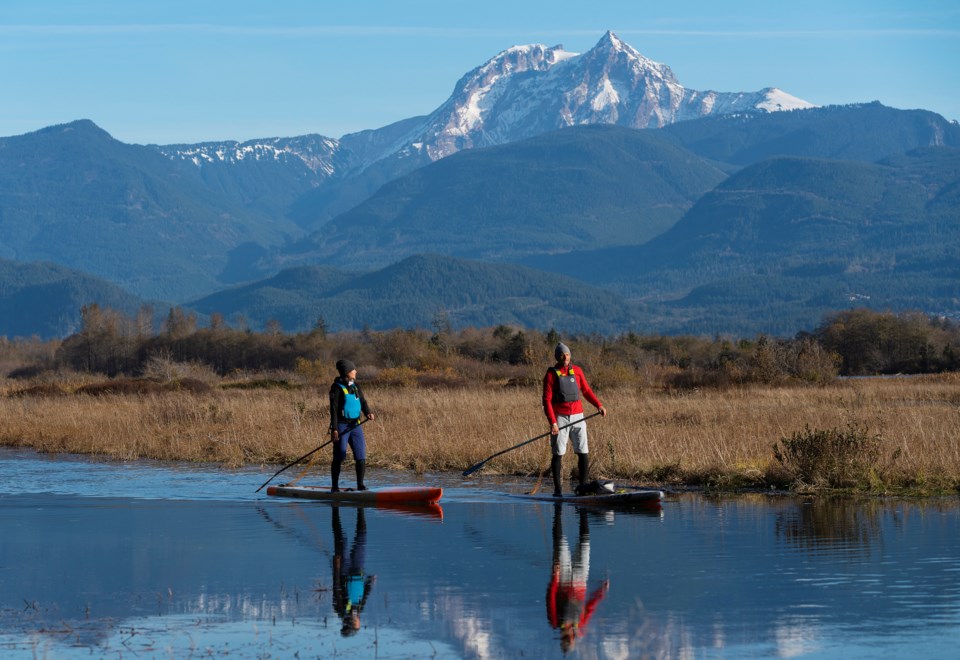With Hot-tober long gone, you might think it’s time to pack up and store the paddling gear until the sun comes back in the spring.
But for some hardnosed folks, the fall and winter still offer opportunities to get out on the water.
With that in mind, Tina Currie, a Paddle Canada certified instructor and a lead guide with Norm Hann Expeditions, shared some tips about how to get out onto Howe Sound and other bodies of water safely. Currie’s main focus is stand-up paddle boarding (SUP), but many of her tips can be considered sage advice for all types of paddling.
For Currie, the biggest piece of advice comes way before you ever get near or in the water.
“For anybody heading out on the ocean, whether it’s summer or winter, they have three checks,” she said. “Checking the weather, checking their gear and their systems, and then also checking their location.”
Currie explained that checking the location means informing someone of where you are paddling to and from and letting them know of your plan.
Another important aspect of paddling safely is wearing a personal flotation device (PFD) and having a whistle, both of which are required by Transport Canada said Currie.
But, she added that having a leash attached between you and your SUP board is an extra level of safety.
“To me, it is probably as important,” she said. “You lose that board, then you’re running into problems.”
“Chances are all the safety gear that’s in the dry bag, such as possibly your phone, the extra clothes are all in that bag. And now that bag is sitting on top of your board, floating away from you.”
After these three checks and gathering your safety gear, there’s the proper clothing.
Currie said there are many different options depending on the paddling you want to do.
For example, she said she might wear a drysuit if she’s planning a multi-day expedition because it would keep her completely dry despite the elements. The downside is that drysuits are often the most expensive option.
Currie said if she’s going for a short paddle or a fitness-oriented paddle — like her CoastalFIT program — then she’s more likely to wear long tights and possibly a thin neoprene layer with Gore-Tex shorts or pants. But this type of clothing will not keep you fully dry if you go for a dip, so it’s more recommended for those that have had experience paddling and are aware of the risks.
Something else to consider is the type of footwear you will need to keep your feet warm, as they are mostly standing still while paddling. Currie said neoprene booties work well but also suggested getting full waterproof boots worn with wool socks to buffer the cold.
A special tip she has for those with neoprene booties is to bring a thermos with hot tea or water.
“And you can pour those on your feet every half hour,” she said.
The last tip Currie passed on was about knowing your area.
For those who are new to the water, it is best to go with a guide or a friend who has experience. The intro courses she offers begin in the Mamquam Blind Channel, as it is much more protected from wind and waves than the open ocean.
If finding a guide or friend doesn’t pan out, Currie suggested looking into local groups like the Squamish Paddling Club, which sometimes hosts social paddles.
You can also ask at a local gear store about safe places to start.
On Nov. 30, the Squamish Paddling Club is presenting 'Winter on the Water' at Valhalla Pure Outfitters. It is a social event to raise money for the Royal Canadian Marine Search and Rescue.
And though Norm Hann Expeditions doesn’t necessarily do a lot of courses through the coldest months, Currie said you can always reach out and they will do their best to help — whether that be hosting a course or offering up local knowledge.
“We offer what’s called Intro to Stoke; we don’t really offer it through this winter time,” she said. “But if four people minimum came to me, I would absolutely support that and take them out.”
For more information on Norm Hann Expeditions, visit NormHann.com. For information about the paddling club, visit SquamishPaddlingClub.com.



